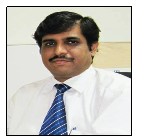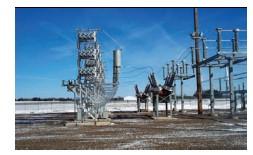 — Shylendra Kumar, Chairman, IEEMA—Capacitor Division
Shylendra Kumar
— Shylendra Kumar, Chairman, IEEMA—Capacitor Division
Shylendra Kumar who chairs the Capacitors Division of
Indian
Electrical & Electronics Manufacturers' Association (IEEMA)
observes that the prospects for the capacitor industry are
encouraging, governed by the sheer pace of power capacity
addition. Although the industry is growing, as it did by over 30
per cent in 2010-11, the volume of capacitors consumed in
India is highly incommensurate with the true potential. The
industry could do better if other demand drivers like power
quality and harmonics mitigation are exploited to a greater
extent, he feels. An interview by
Venugopal Pillai.
We understand that the capacitor industry, as measured by the performance of IEEMA companies,
grew by over 30 per cent in 2010-11. What factors have been responsible for
this high growth and what are prospects for 2011-12?
Yes it did, the capacitor industry as measured by the production volumes of IEEMA
members did grow by 32 per cent in 2010-11 compared to 2009-10. The same is mainly
powered by higher growth in LV capacitors segment which contributed to about 44 per
cent growth and followed by HV capacitor production which reported 18 per cent
growth. The demand for low voltage as well as high voltage capacitors in India is
generally good but the production volumes are a mix of domestic supply and also large
amount of exports especially in the LV Capacitors as some of the reporting companies
are global hubs and supply for global markets. However, the domestic consumption of
LV capacitors both MPP type and APP type capacitors has increased due to large utility
tenders and also industrial growth. PGCIL does provide large volumes for HV due to
projects in series compensation and HVDC filter capacitors.
Prospects for 2011-12 remain at the same level of growth in the domestic market
which is estimated around 15-20 per cent for LV and around 10 per cent for HV.
Production volumes for global markets will obviously depend on the global market
scenario in US and Europe. While the markets for Indian capacitors in Middle East,
Africa and South East Asia will remain good.
How has been the growth IEEMA membership (in the capacitor industry) in
recent years?
In the recent years there has been 4-5 new additions to IEEMA membership.
Talking about high-tension capacitors, what is the health of the Indian industry? Are
Indian suppliers competitive enough in the domestic and global market?
The health of Indian industry in HV capacitors can be rated as
good with respect to growth in volumes but it is far from
satisfactory when it comes to price levels which is
continuously falling and is a matter of concern.
At the present price levels, the competitiveness of Indian
capacitors is rather good both in domestic and global markets.
Chinese entry into Indian capacitor market is so far limited.
Competitiveness with respect to Chinese capacitors still needs
to be evaluated.
Given that a capacitor is a crucial product with respect to
achieving efficiency in power consumption (higher power
factor), how do you gauge the prospects of the capacitor
industry, generally speaking?
With the growth in power sector and the additions of mega
watts (MW) which is certainly growing in a healthy manner, the
additions of MVArs (Capacitors) to improve the power factor
and thus improve the efficiency of power utilization has a very
good prospect for growth. Additional prospects for capacitors
are arising above the factors like focus on power quality,
harmonic mitigation and improvement in productivity by
improving power quality.
 What would be the industry's major growth drivers?
What would be the industry's major growth drivers?
The capacitor industry's major growth driver is the growth of
the power sector itself. Also as already mentioned, power
quality issues and raising levels of non-linear loads such as
inverters/converters/power electronic devices, etc. lead to
high harmonic content in the power system and hence the need
for both HV and LV filters (both passive and active) will be
another major driver. The link between productivity in sectors
like steel, aluminum, cement and automobile to the quality of
power meaning power factor, maximum demand, THD (Total
Harmonic Distortion) is increasingly recognized and will also
drive the usage of filters, SVC and dynamic compensators, all
of which will help further growth.
We observe from CEA statistics that India's shunt capacitor
installation programmes by power utilities are progressing
rather slowly. Do you think this depresses the growth
prospects of the capacitor industry?
Yes, it is a fact that the Indian shunt capacitor programmes
like APDRP projects and the installation of shunt capacitors in
some utilities have really slowed down as compared to the
growth in the MW which does upset the production plans of
the capacitor industry. Large substation tenders are planned
by SEBs without capacitors being a part of it many a times.
Capacitors are added (sometimes not) at a later date,
whereas in China capacitors are an integral part of substation
package specification.
We perceive that a large number of capacitor manufacturers
are in the SME category. What is your view and what has been
your approach in inducting them into the IEEMA fold?
In LV capacitors it is estimated that more than 30 per cent LV
capacitor production comes from SME category. While some of them can be classified as unorganized and
low quality manufacturers, not all of them
are bad. The Quality Cell of IEEMA is
continuously engaged in motivating and
training SMEs to improve the quality
standards and also reward outstanding
achievements by SME on a regular basis
and give them visibility to motivate them to
a higher level of quality position. SMEs who
qualify a minimum level of entry criteria are
inducted into IEEMA on a regular basis.
What are the typical challenges that the
Indian capacitor industry faces and what
has been IEEMA's role in addressing some
of these concerns?
One of the major concerns in the recent
past has been raising input material costs
coupled with falling market price levels.
IEEMA plays an important role in updating
and revising the price variation clause
(PVC) which to some extent gives
coverage to the capacitor suppliers in
covering their increased materials costs
and labour costs.
Although the capacitor segment sees
relative growth year on year, the actual
volume of capacitors that are really
needed to bring down the transmission
and distribution losses are much below
the required level. It is well known that our
T&D losses are very high and given the
MW generation and utilization factor can
certainly be improved by usage of
capacitors. Even the levels of harmonics in
many industries are so high that the
quality of power (distortion of sine wave)
creates a lot of premature failures. The
installation of filters however is far below
the required level. IEEMA is trying to
address this by conducting CAPACIT
seminars, programmes like DRUM, etc. to
increase the awareness level and benefits
that can be derived out of connecting
capacitors to their systems.
IEEMA is also planning representations
to utilities and large industries to promote
usage of capacitors.
As Chairman of IEEMA's capacitor division,
what would be your three biggest
priorities?
The priorities for IEEMA are mainly:
- Increase awareness amongst the
utilities as well as industries
regarding efficient usage of power
and the role of capacitors in
achieving the same.
- Improve the bad image of capacitors
created by unorganized sector due to
high failure rate by raising the
qualifying requirements for supplying
capacitors and also improve the
quality processes of SMEs through
IEEMA Quality cell.
- Organizing seminars, platforms and
training courses involving capacitor
manufacturers, testing and research
institutions like CPRI / ERDA and also
liaison with BIS committees like ET 29
(which formulates Indian Standards)
to discuss and improve standards of
technology, standardization and
product quality.